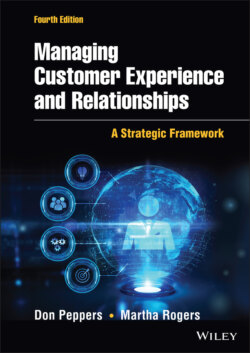Читать книгу Managing Customer Experience and Relationships - Don Peppers - Страница 20
WHAT IS A RELATIONSHIP? IS THAT DIFFERENT FROM CUSTOMER EXPERIENCE?
ОглавлениеWhat does it mean for an enterprise and a customer to have a relationship with each other? Do customers have relationships with enterprises that do not know them? Can the enterprise be said to have a relationship with a customer it does not know? Is a relationship possible if the company knows the customer and tailors offers and communications, remembers things for the customer, and deliberately builds customer experience—even if the customer is not aware of a relationship? Is it possible for a customer to have a relationship with a brand? Perhaps what is thought to be a customer's “relationship with a brand” is more accurately described as the customer's attitude or predisposition toward the brand. This attitude is a combination of impressions from actual experiences with that brand, as well as what one has heard about the brand from ads (company-originated communication), from news, and from others (comments from friends and ratings by strangers). Experts have studied the nature of relationships in business for many years, and there are many different perspectives on the fundamental purpose of relationships in business strategies.
This book is about managing customer relationships and experiences more effectively in the 21st century, which is governed by a more individualized approach. The critical business objective can no longer be limited to acquiring the most customers and gaining the greatest market share for a product or service. Now that it's possible to deal individually with separate customers, the business objective must include establishing meaningful and profitable relationships with, at the least, the most valuable customers, and making the overall customer base more valuable. Technological advances during the last quarter of the twentieth century have mandated this shift in philosophy.
Managing the customer relationship is all about what the company does, and customer experience is what the customer feels like as a result.
In short, the enterprise strives to get a customer, keep that customer for a lifetime, and grow the value of the customer to the enterprise. Relationships are the crux of the customer-strategy enterprise. Relationships between customers and enterprises provide the framework for everything else connected to the customer-value business model, even if the customer is not aware of the relationship. After all, the customer is aware of what they experience with the company. In fact, we could say that managing the customer relationship is all about what the company does, and customer experience is what the customer feels like as a result. The exchange between a customer and the enterprise becomes mutually beneficial, as customers give information in return for personalized service that meets their individual needs. This interaction forms the basis of the Learning Relationship, based on a collaborative dialogue between the enterprise and the customer that grows smarter and smarter with each successive interaction.8
